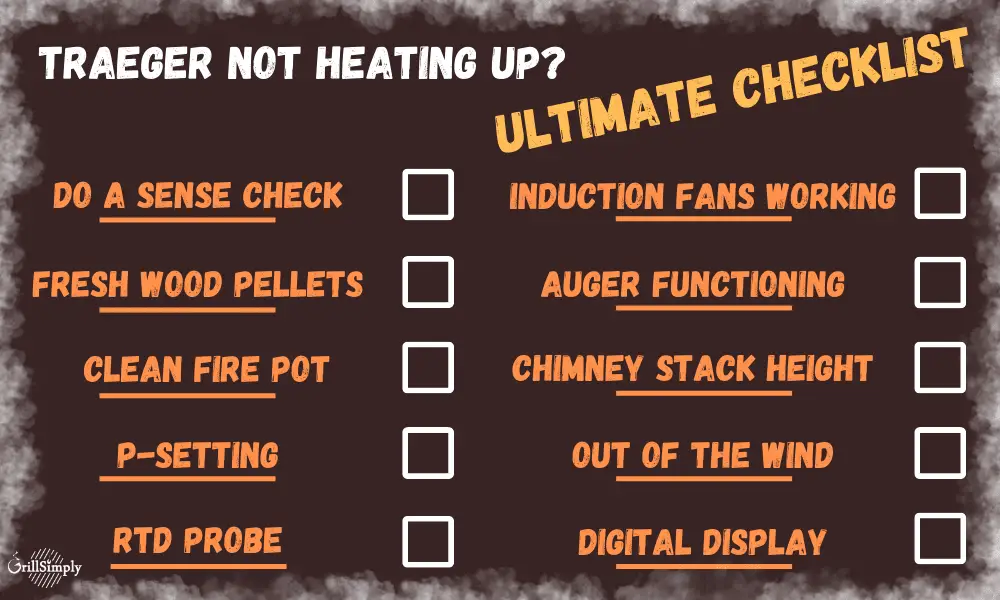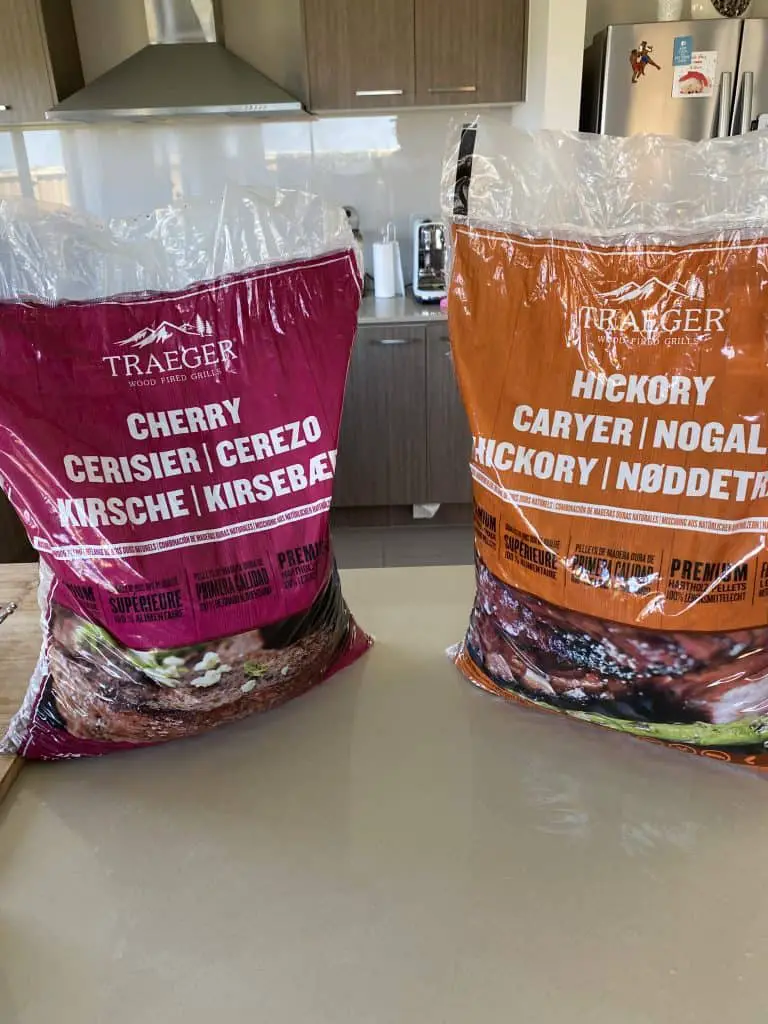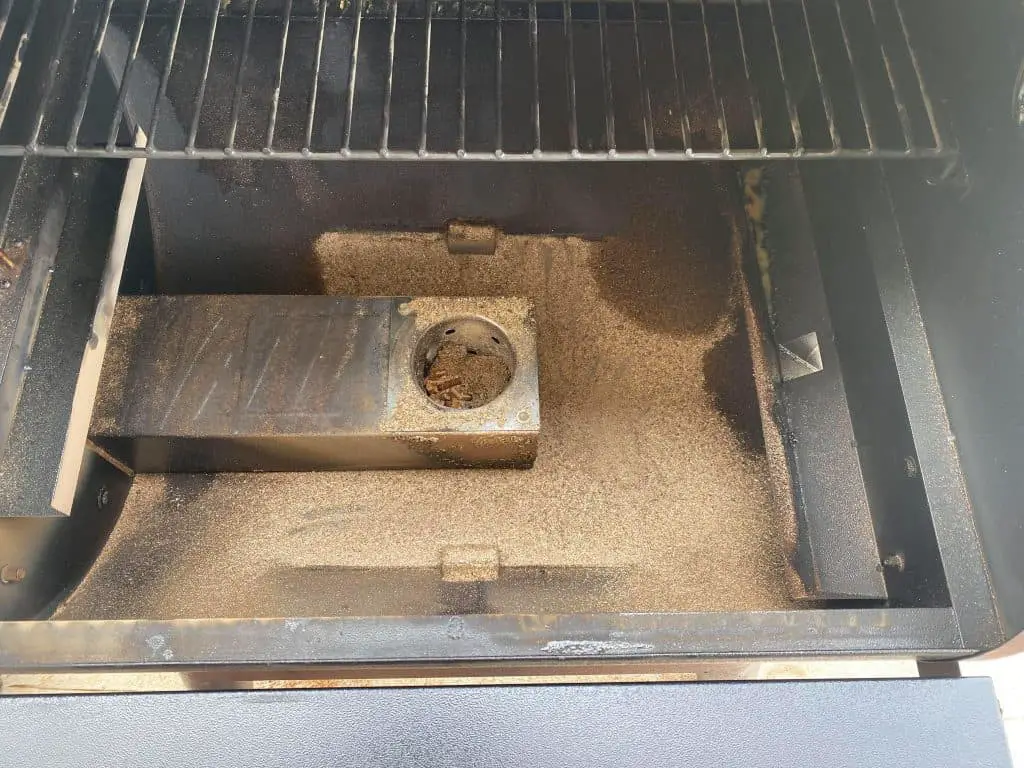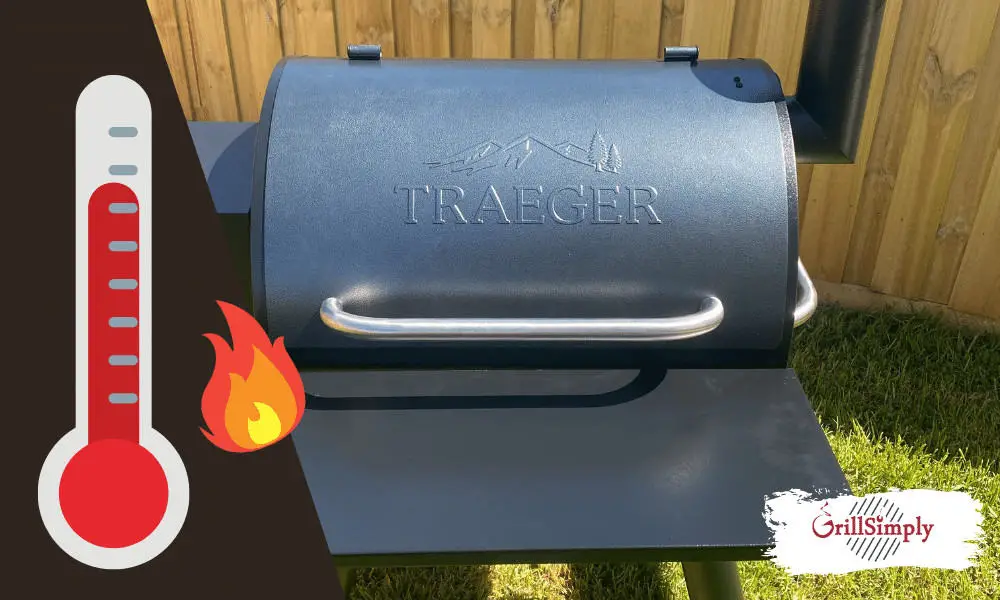One of the worst feelings possible is preparing for a barbecue feast, only to find your Traeger isn’t heating up to your desired temperature.
It’s strange, isn’t it? No matter what you do you just can’t seem to reach that sweet spot for smoking that you want.
The first thought is, “what’s happened to my Traeger!?”
But don’t worry. A Traeger Grill that’s not heating up isn’t always permanent, and it can be caused by some pretty simple reasons.
So, if you’re scratching your head as to why your Traeger just isn’t heating up, we’ve got you covered. Here are the most common reasons your Traeger won’t heat to 300°F, 450°F, or max temperatures, all in an ultimate checklist.

Traeger Grills are known as being one of the most consistent, easy to use, and reliable pellet grills in the market today – and for good reason!
So, it’s understandable to get a little bit uneasy when you discover your Traeger’s not working the way it should.
But, don’t panic. The first step is to do a quick sense check on the basics. Then, by a process of elimination, you can go through the various checks to see what’s causing the stale temperatures.
Here’s the ultimate checklist, with every possible reason that your Traeger Grill isn’t heating up to your desired temperature:
- Do A Sense Check
- Fresh Wood Pellets
- Clear & Clean Fire Pot
- P-Setting
- RTD Probe
- Induction Fans Working
- Auger Functioning
- Chimney Stack Height
- Out Of The Wind
- Digital Display
Note: Check out this guide if your Traeger Grill won’t ignite at all!
Do A Quick Sense Check
Look it sounds simple, but before you begin to troubleshoot your Traeger Grill there’s a few basic things to look for as a quick sense check.
- Check your Traeger is plugged in and receiving adequate power.
- Check you have wood pellets in the hopper.
- Check your fire pot is clean and clear of debris.
These basics should be the first thing you check before starting your grill, every time. Just to be sure things are in order and you’re ready to cook! After all, your Traeger needs power and wood pellets to generate heat, right?
Use Fresh Wood Pellets

One of the most overlooked things that can play a major part in generating heat in your Traeger is your wood pellets.
When wood pellets absorb moisture they lose their integrity, and begin to degrade, crack, or crumble. Especially when they are pushed through the auger.
This doesn’t always mean your wood pellets will be damp to the touch, they can absorb moisture when stored incorrectly or have been exposed to the rain or humidity.
Damp or moist wood pellets can lead to problems in the auger, backfire, or at the very least, temperature issues!
To test if your wood pellets are fresh you can do the “Snap Test”. Take a wood pellet and begin to slowly bend it. If they’re fresh you will feel some resistance before a distinct “snap” when it breaks. If it simply crumbles or doesn’t snap then they are not fresh!
Clear & Clean Your Fire Pot

The fire pot is where the auger feedings the wood pellets for ignition and heat.
If the fire pot is full of wood dust and debris, then the wood pellets won’t be able to be fed through in their normal fashion. Inevitably this causes temperature problems and often leads to your Traeger struggling to get up to temperature.
To combat this, you can always vacuum your fire pot and grill, or clean it out carefully.
You’ll be amazed and how much smoother your smoke-session will actually go if you do this every time.
P-Setting
For new Traeger owners this is often unknown, but, all pellet grills have a p-setting.
The P-setting refers to “pause” and controls how frequently the wood pellets are fed through the auger.
The higher the p setting, the slower your wood pellets will flow through to feed the blame.
To adjust your p-setting on your Traeger, simply use a pin to poke into the small hole next to the digital display.
If you’re having temperature issues and your Traeger isn’t heating up to your desired temperature, try adjusting the p setting to 1 or 2, allowing more fuel for the fire!
RTD Probe
The RTD probe, or Resistance Temperature Detector, is essentially what the internal temperature sensor.
This little metal rod, or thermocouple, is directly responsible for controlling the temperature inside the grill.
If the internal temperature of the Traeger is higher or lower than what it’s recording on the digital display, then there’s likely something with this probe.
Don’t worry, replacements are easy to source from Traeger and are surprisingly easy to install.
Induction Fans Working
There’s a simple test to see if your induction fan’s working. You turn on your Traeger and listen.
Induction fans should make a clear and consistent sound. If it’s really quiet, inconsistent, or just sounds wrong then it’s worth investigating and potentially replacing your induction fan.
You can find your induction fan just below the grill. If you turn your Traeger on you should see the fan start to turn. If it’s looking sluggish or you aren’t feeling good air suction then it may be time to replace it!
The Auger’s Functioning
The auger is the rotisserie, drill-like tube that connects the hopper to the fire pot. It directly feeds the wood pellets to ensure the flame has a constant feed, keeping the temperature consistent.
A malfunctioning auger can mean your pellets are being fed more slowly, impacting the temperature of grill.
If you empty out the hopper you’ll see the bottom of the auger. Turn on your Traeger and simply watch the auger. If it’s not turning or the wood pellets aren’t being fed through, then further investigation is needed, and unfortunately it may need to be replaced.
Chimney Stack Height
Smothering flame is the easiest way to put it out. No oxygen, no flame, no heat, no barbecue.
To allow for adequate oxygen into the smoker, allow at least a one to one and a half-inch gap between the chimney, and the chimney cap. This is referred to as the chimney stack height, and it’s been debated for as long as pellet grills have been around.
Windy Or Harsh Weather
People always think that rain and cold is a Traeger’s worst nightmare, but really it’s strong winds!
The placement of your Traeger really does make a difference. If the wind is flowing through your Traeger it can feed too much oxygen to the grill, or can constantly blow the smouldering flame in the fire pot.
Still, you shouldn’t use your Traeger in the garage or inside, but you should place it out of the wind and ideally covered from the elements.
Believe me, if it’s windy and you’re struggling with maintaining or reaching high temperatures on your Traeger then the wind is normally the main culprit!
Digital Display
It sounds simple but it’s entirely possible your digital display is not working properly.
It’s possible your digital display could simply be reading the wrong temperature, so you can always try using a different thermometer to test the heat inside the grill and in the chimney to see what the temperature really is.
It could also be that your Traeger isn’t registering that you are placing it on a higher temperature too!
If it’s your digital display, you can order a replacement or get it fixed at your local grill repairer.
Traeger Not Heating Up To 300°F?

When you’re looking at smoking at that sweet spot of 300°F, whether it’s for beef ribs or smoking chicken wings, you just can’t settle for 225-250°F. Particularly if you’re trying to get crispy skin on smoked chicken or smoked turkey!
If you’ve found your Traeger will heat up to 225-250°F but no matter what you do it won’t budge up to 300°F then you’ve got a problem.
If your Traeger will heat up, but won’t heat up to 300°F, then it’s most likely the RTD Probe or Auger Fan. Still, be sure your Traegers not in the wind, and your wood pellets are fresh and dry!
Traeger Not Heating Up To 450°F?
It’s not often you’ll want to blast your barbecue at 450°F. But, it’s frustrating if you plan to do it only to discover you can’t…
Because high temperature calls for more wood pellets, you may find that changing your P-setting to 1 will drastically help heat up and maintain high temperatures.
Otherwise, there’s not usually anything internally wrong with your Traeger if it’s not getting up to 450°F. It’s normally external conditions that will prevent it from getting there if it can reach all other temperatures.
Check you’re using high-quality wood pellets, fresh and dry. Be sure your Traeger is out of the harsh weather, or try a Traeger Insulated Blanket to help retain heat.
Final Thoughts
I’ve said it once and I’ll say it again, the most often culprit of a Traeger not heating up is sometimes the most obvious.
Check your wood pellets are fresh by doing the “Snap test”, check the basics are all working and your firepot is clear and clean. Check you’ve got enough pellets in the hopper too!
If things still aren’t heating up to your desired temperature, systematically go through every individual part of your Traeger and see what’s causing the issue.
If you go through this master checklist and still haven’t found the answer, feel free to drop a comment below so we can all lend our minds.


1 thought on “Traeger Not Heating Up To High Temps? (300-450°F)”
I have a BBQ400 series Traeger that had issues reaching and keeping high temp. I found propping the lid open 1/2” would instantly solve the problem but the handle got very hot. I drilled the lid hinge holes 1/2” above the old holes and reattached the lid hinge bolts through them. Traeger fixed!
425° in under 15 minutes.